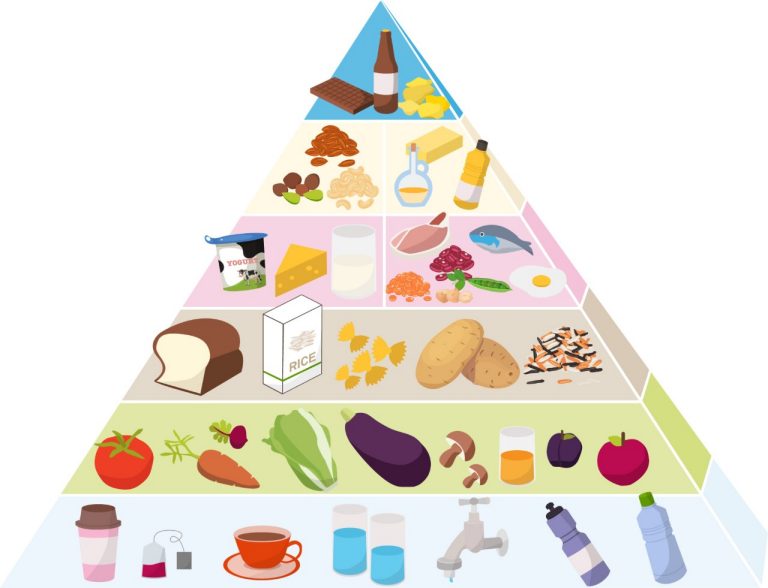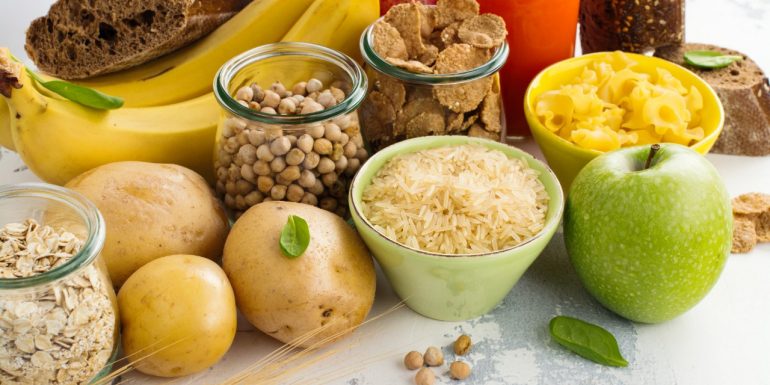
Food pyramid for Switzerland: explanation & structure
What is a food pyramid and what are the six food groups in the Swiss food pyramid? Are there specific food pyramids for children and pregnant women? Find out more about the new food pyramid now.
Food pyramid: definition
What is a food pyramid? The food pyramid shows all the elements of a balanced diet. It categorises different foods into groups and shows which we should eat more of and which we should eat less of. The food pyramid’s recommendations are tailored to the needs of healthy people aged between 18 and 65.
Structure of the Swiss food pyramid
The food pyramid for Switzerland has been devised by the Swiss Society for Nutrition (SSN). The SSN updated the Swiss food pyramid in 2024. As before, it consists of six levels and is structured as follows:

The foods shown on the bottom levels should be eaten in larger quantities, and those shown at the top levels in smaller quantities.
Level 1 of the food pyramid: drinks
Level 1 of the food pyramid is the bottom level and, as such, forms the basis of a balanced diet. Drink one to two litres of unsweetened beverages a day, for example tap water, mineral water or unsweetened fruit or herbal tea. These will provide your body with fluids and important minerals. Drink regularly over the course of the day, because your body doesn’t build up any fluid reserves. Caffeinated drinks like coffee are another source of fluid, but these should be consumed in moderation – for example, no more than three cups of coffee a day.
Level 2 of the food pyramid: fruit and vegetables
The second level of the food pyramid comprises fruit and vegetables. Three portions of vegetables and two portions of fruit a day are ideal. One portion is around 120 g. That’s equivalent to about a handful. Variety is best – the more colourful, the better. Fruit and vegetables contain plenty of vitamins, minerals and dietary fibre as well as secondary plant products.
Level 3 of the food pyramid: cereals and potatoes
Level three of the food pyramid relates to carbohydrates. Cereal products and potatoes are very high in carbohydrates and supply the body with energy. Ideally, you should eat three portions a day and opt for wholegrain products. These are richer in nutrients than products made from white flour and fill you up more quickly and for longer.
Your daily portion of foods from this level might include:
- 75 g to 125 g bread
- 200 g to 300 g potatoes
- 45 g to 75 g oats, rice or couscous (dry weight)
Level 4 of the food pyramid: pulses and animal products
Level four of the food pyramid is split into two parts:
- Dairy products: for products that are made from milk, the food pyramid recommends two to three portions a day. This ensures that the body is well supplied with protein, calcium, iodine, vitamin B2 and vitamin B12. One portion, for example, includes 200 ml of milk, 150 g to 200 g of unsweetened yoghurt, 150 g to 200 g of cottage cheese or 60 g of soft cheese.
- Pulses, eggs, meat and fish: these foods are also rich in protein and vitamin B12. It is best to alternate and eat pulses at least once a week, e.g. chickpeas or lentils. A portion of pulses consists of about 60 g. Consume meat a maximum of two to three times a week. One portion of meat is around 100 g to 120 g. It’s best to limit your consumption of processed meat (cervelat, salami, ham) to once a week.
Vegetarian and vegan food pyramid
There is no vegan or vegetarian food pyramid. In this case, you can also refer to the new food pyramid for Switzerland – it also shows vegetarian sources of protein, for instance eggs and dairy products. Ideally, vegans should cover their protein requirements with pulses, tofu, tempeh, seitan, quorn, soya drinks and yoghurt alternatives made from soya. The SSN also provides some additional nutrition tips for those who follow a vegan or vegetarian diet.
Those who follow a vegetarian or vegan diet should consult a doctor, because the above-mentioned protein-rich foods do not cover vitamin B12 requirements. In some cases, it is therefore advisable to take vitamin B12 food supplements.
Level 5 of the food pyramid: nuts, seeds, oils and fats
The fifth level of the new food pyramid is also split into two parts:
- Nuts and seeds: eat between 15 g and 30 g of unsalted nuts or seeds a day. This is roughly equivalent to a small handful and provides you with important fats and plant fibres. Nuts and seeds include hazelnuts, walnuts and sunflower seeds.
- Oils and fats: consume 20 g of vegetable oil per day. That’s two tablespoons, one of which should ideally be rapeseed oil. Fats such as margarine or butter should be limited to a maximum of 10 g per day. Foods that are particularly high in fat, i.e. cream sauces or fried foods, should only be consumed in moderate quantities.
Level 6 of the food pyramid: sweets, salty snacks and alcohol
At the top of the food pyramid are the foods that are high in calories but otherwise contain no important nutrients. These include soft drinks, chocolate and crisps as well as alcohol. Enjoy them in moderation, eat a maximum of one portion a day, for example:
- 200 ml of soft drinks (cola, iced tea, light/zero drinks)
- 20 g of chocolate
- 20 g of crisps or salted nuts
Important: do not consume alcoholic beverages and sweets every day.
Country-specific food pyramids
There is no universal version of the food pyramid. In addition to the food pyramid for Switzerland, there are, for example, American, Austrian and Japanese food pyramids. They differ in form and recommendations but also have some things in common: most advise limiting your salt intake and only consuming saturated fatty acids from animal products in moderation. Fruit, vegetables and unsweetened beverages such as tea and water also play an important role across all the different pyramid versions.
What is the difference between the food pyramid and the plate model?
In addition to the food pyramid, there is also a plate model devised by the SSN. This model uses the example of a plate to show which food groups make up a balanced meal. It also shows how much each of these food groups should ideally feature in a meal. A balanced meal contains the following foods:
- A drink: preferably water or unsweetened tea
- Fruit and vegetables: they comprise roughly 2/5 of the meal.
- Starchy foods: these make up around 2/5 of the meal.
- Protein-rich foods: these constitute roughly 1/5 of the meal.
The size of the portions depends on the individual’s energy requirements.
Alternative food pyramids
There are various alternative food pyramids in addition to the SSN’s Swiss food pyramid. They offer guidance for specific dietary goals. Examples of alternative food pyramids include:
- The paleo food pyramid: the paleo diet is based on a Stone Age diet. The basis of this diet is plenty of vegetables and fat as well as meat, fish and eggs. At the second level of this pyramid is fruit, followed by nuts and seeds. The last level includes honey and maple syrup. Processed foods, sugar, pulses, grains and dairy products do not form part of the paleo diet.
- Mediterranean food pyramid: the Mediterranean diet features a balanced mix of different foods: the first level includes wholegrain products, bread, beans and nuts. These are particularly common in the Mediterranean diet. They are followed by fruit and vegetables. Above this is olive oil. The fourth level includes fish and seafood – ideally, these should feature on the menu several times a week. Smaller amounts of eggs, cheese and yoghurt supplement the protein intake. Meat and sweets are rarely on the menu. Plenty of water ensures adequate hydration.
- Keto food pyramid: the ketogenic diet includes a high percentage of fat and very few carbohydrates. This diet is primarily comprised of sources of fat such as nuts and seeds, avocado and vegetable oils. At the top are proteins from seafood, eggs, fish and meat. This is followed by carbohydrates from vegetables and fruits. The ketogenic diet avoids grains, pulses, potatoes, root vegetables, as well as fruit and vegetables with a high sugar content (bananas, grapes, carrots). Processed foods, soft drinks and sugar substitutes are also off-limits.
Food pyramid: a basis for different needs
The food pyramid serves as a helpful guide for all those who want to eat a varied diet. It is suitable for very different life situations and needs – including children or pregnant women. As illustrated by the example below, the basic principles are always similar.
Food pyramid for children
There is no specific food pyramid for children. However, the SSN has a food plate that is tailored to the needs of children. It contains recommendations that are similar to the food pyramid in many respects:
- Ideally, children should drink four to five glasses of water a day.
- In addition, they should eat colourful vegetables and fruit with all main meals and snacks.
- If possible, children should eat several meals evenly spaced throughout the day.
Parents should provide their children with a varied diet. Shared mealtimes where everyone takes their time support healthy eating habits. Nutrition education is also important: for instance, covering the food pyramid at school and introducing children to a balanced diet can be very helpful.
Food pyramid during pregnancy
There isn’t a separate food pyramid for pregnant women either. In fact, the ideal pregnancy diet is based on the food pyramid for Switzerland. However, there are special recommendations for pregnant women:
- Experts advise pregnant women to avoid soft and semi-hard cheese as well as feta and blue cheese.
- During pregnancy, opt for oily fish such as salmon. Low-fat meat such as poultry is also allowed, but red meat (pork, beef and lamb) should be eaten in moderation. Avoid raw fish and raw meat.
- Do not drink alcohol during pregnancy.
Food pyramid for athletes
The food pyramid is also suitable for athletes as a basis for a needs-based and balanced diet. Ideally, however, athletes will adjust their fluid intake, especially during training sessions. Consume an additional portion of wholegrain products and half a portion of oils, fats or nuts per hour of exercise.
Food pyramid for weight loss
If you want to lose weight, it is also best to follow the Swiss food pyramid. This will ensure you continue to supply your body with important nutrients. Also, take enough time when you eat. Listen to your body and eat mindfully. This will help you recognise when you are full. Exercise for at least 30 minutes a day: do sports, go for a walk or a bike ride.
Create your own food pyramid
Our tip for following a balanced diet: the SSN provides a blank food pyramid. Enter the food you want to eat in this empty food pyramid. Choose the foods that you eat frequently and like to eat from each category. This food pyramid will help you create a daily schedule tailored to your specific needs and preferences. Lay the foundation for a balanced diet: use the Swiss food pyramid as a guide and take into account your individual needs. Get inspiration from the Helsana Coach app and do all you can for your well-being every day.

The specialist provided the editorial team with advice and input for this article. Andrea Bovisi (BSc BFH dietitian) works in the Helsana Health Consultation Service. She helps customers on issues to do with nutrition and health promotion.


Newsletter
Find out more about current health issues every month and get all the information you need about our attractive offers from all Helsana Group companies * delivered by e-mail to read whenever it suits you. Our newsletter is free of charge and you can sign up here:
We did not receive your information. Please try again later.
* The Helsana Group comprises Helsana Insurance Company Ltd, Helsana Supplementary Insurances Ltd and Helsana Accidents Ltd.